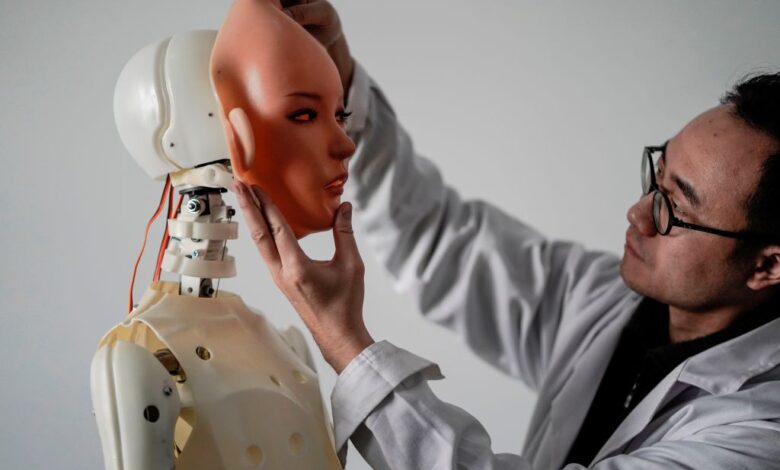Report finds no evidence sexbot use is healthy

By Ben Guarino | Washington Post
Sex sells, and robots are no exception. One of the most expensive consumer robots under development, a machine named Harmony, is a $15,000 union of silicone curves and silicon chips. Part of an estimated $30 billion industry, Harmony has software that remembers birthdays and can quote Shakespeare, per the Guardian. Harmony is also equipped for intimate human-robot relations. Sex doll maker Realbotix, in its marketing materials, bills Harmony as “the perfect companion.”
But healthy companionship is too bold a claim to make about sex robots, warn a pair of doctors in a report published Monday in the BMJ Sexual & Reproductive Health.
Chantal Cox-George, a doctor at St. George’s University Hospitals in Great Britain, and Susan Bewley, an obstetrician at King’s College London, scoured the medical literature for reports concerning the health aspects of sex robots. They finished their search as they began: Empty-handed.
No primary research data on sex robots exist, the doctors concluded. “We advise that sexbots shouldn’t be used in medical practice,” Cox-George said, “at least not unless that forms part of robust and ethical research.”
Noel Sharkey, an emeritus professor of artificial intelligence and robotics at the University of Sheffield in England, applauded the BMJ article. In May 2017, Sharkey, as a co-founder of an organization called the Foundation for Responsible Robotics, produced a report outlining the sexual future of humans and robots.
The Foundation for Responsible Robotics talked to “an awful lot of people,” Sharkey said, and none could provide evidence for clinical uses. The BMJ report goes “a lot further than we did and actually delved into hundreds and hundreds of journals,” he said, yet arrived at the same conclusion.
The lack of empirical data is no surprise to Julie Carpenter, a research fellow at the Ethics and Emerging Sciences group at California Polytechnic State University. Robotics researchers haven’t neglected to think about these questions, she said, but only within the past few months have sex robots been widely available for purchase.
A data void hasn’t prevented the spread of beneficial claims. “We became aware that doctors are being asked for their professional opinions on sex dolls and robots,” Cox-George said. Sexbots have been suggested as a way to promote safe sex or as therapies for people with companionship problems.
In an interview published last year, Douglas Hines, chief executive of interactive sex doll maker TrueCompanion, told the Foundation for Responsible Robotics: “Roxxxy, our sex robot, provides what every adult needs – unconditional love and support. The ability to feel the loving embrace of a lover is a right every adult should be granted. We provide a solution to help adults meet their social as well as sexual needs.” (TrueCompanion and Realbotix did not respond to requests for comment.)
That a sex robot could alleviate social isolation is a common theme. A recent New York Times column equated robots with human sex workers and suggested that self-described incels – meaning “involuntarily celibate” – will attempt to find fulfillment in having sex with machines.
Sex robot manufacturers have also engaged in “massive marketing” that cites benefits to those who struggle to make human connections, Sharkey said, but those claims are on shaky ground.
“A lot of experts are saying it would not help with social isolation,” he said, “and might even make them more socially isolated.” Sharkey said he knew of at least one case where a man left his wife and children for a silicone doll.
Sex robots have also been suggested as companions for the elderly or people with disabilities. That struck Cox-George and Bewley as “patronizing,” as they wrote in the article, and an argument “for a ‘lesser’ sexual experience when most people with disabilities can form mutually satisfying relationships.”
Kathleen Richardson, an ethics professor at De Montfort University in Great Britain, grew so concerned about the intrusion of machines into human relationships – an area “traditionally off-limits to the market” – that she launched the Campaign Against Sex Robots in 2015.
“It offends me that they think a human woman is like a machine,” she said. (The vast majority of sex dolls are shaped like women.) Sex robots’ ability to satisfy the unsatisfied may also be overblown, Richardson said. She’s heard of men who have gone to “doll brothels” and been unable to become aroused. “It wouldn’t be very advantageous for human beings to be aroused by objects, would it?”
Though scientists frequently say more research is needed, clinical experimentation with sexbots, in Richardson’s view, risks driving research funds into environments where people have sex with machines.
Carpenter disagreed. “I’m not an advocate for releasing a doll into the general public” and claiming it is therapeutic, she said. But she recommends that the door be kept open to explore sex robots “as a critical tool” used with the guidance of a human therapist. The current archetype of sex robots, which mostly caters to male and heterosexual customers, might obscure what comes next. Instead of assuming robots will become replacements, Carpenter said people might be drawn to sex robots thanks to the very features – like nonjudgmental programming — that make them different from us.
For the time being, and given the lack of data, Cox-George and Bewley conclude that medical professionals should apply what is known as the precautionary principle: “There is a social responsibility to protect the public from harm, unless findings emerge to show no harm,” Cox-George said. In the absence of evidence, in other words, clinicians should steer patients away.
You can read the full article from the source HERE.
-
Sale!

Aurora: Tender Sex Doll
Original price was: $2,799.00.$2,599.00Current price is: $2,599.00. Buy Now -
Sale!

Dominique: Thick Sex Doll
Original price was: $2,499.00.$2,199.00Current price is: $2,199.00. Buy Now -
Sale!

Auburn: Red Head Sex Doll
Original price was: $2,199.00.$1,899.00Current price is: $1,899.00. Buy Now






